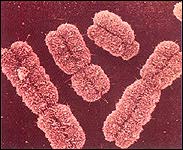The artificial human chromosomes (HACs) technology adds an extra chromosome to the 46 that reside in most cells of the body.
Proponents believe HACs can be made to replicate each time cells divide, and it could be possible to turn their genes on or off at will. It might also be possible to include a self-destruct mechanism that prevents the HAC from being passed on to future generations if necessary.
 Gregory Stock and John Campbell of the University of California believe it will soon be possible to consider therapies that involve inserting specially-designed HACs into human embryos. An HAC could be built containing genes that confer life-long resistance to HIV. Another idea is to introduce into male embryos an HAC containing a series of genetic switches that can, when turned on, trigger the destruction of prostate cancer cells.
Gregory Stock and John Campbell of the University of California believe it will soon be possible to consider therapies that involve inserting specially-designed HACs into human embryos. An HAC could be built containing genes that confer life-long resistance to HIV. Another idea is to introduce into male embryos an HAC containing a series of genetic switches that can, when turned on, trigger the destruction of prostate cancer cells.
If preventative treatments such as these are shown to work safely, one can envisage treatments delivered as a “gene cassette” on a single HAC. For instance, anti-ageing genes could be added to every embryo’s extra chromosome.
One scenario that has been envisaged is the idea of human society being divided between the “gene enriched” and the “naturals” – some people having the resources to exploit all aspects of the technology to improve their life, with others left to live and breed naturally. Princeton University’s Lee Silver believes that although such a dystopia is not imminent, it is plausible and could eventually lead to two species of humans.
“If the accumulation of genetic knowledge and advances in genetic enhancement technology continue at the present rate,” Silver says, “then by the end of the third millennium, the genrich class and the natural class will become the GenRich humans and the Natural humans – entirely separate species with no ability to cross-breed and with as much romantic interest in each other as a current human would have for a chimpanzee.”
Via The Independent.







